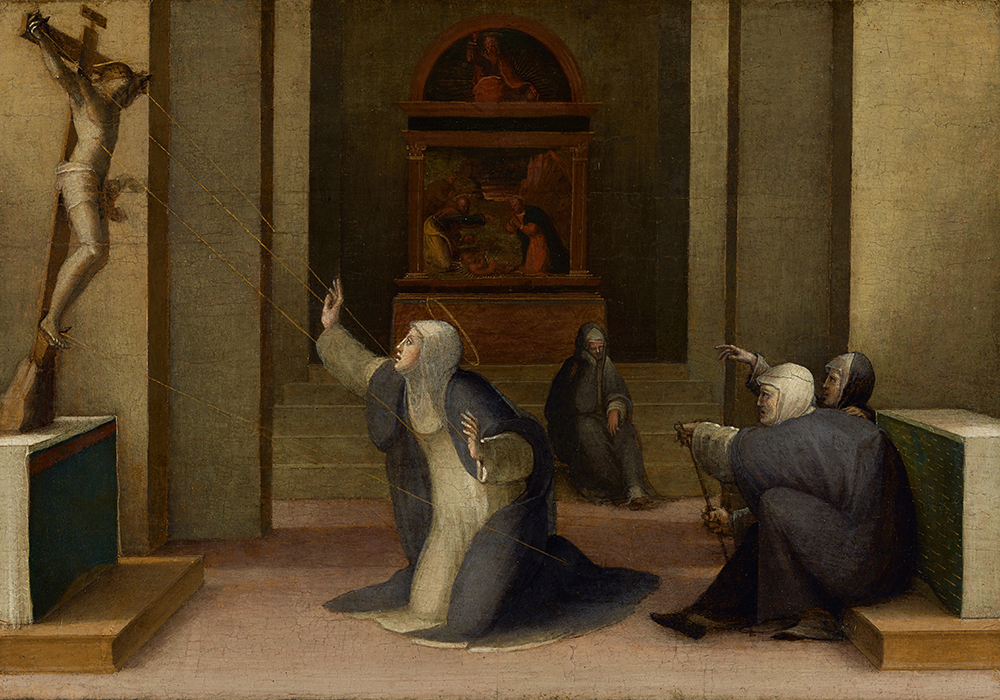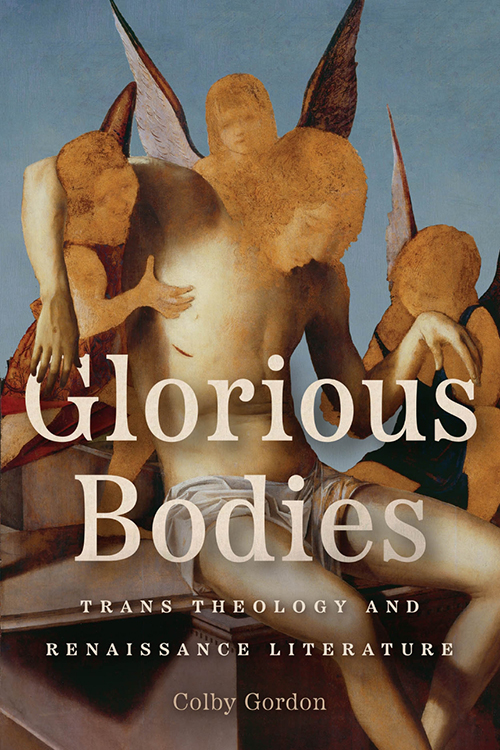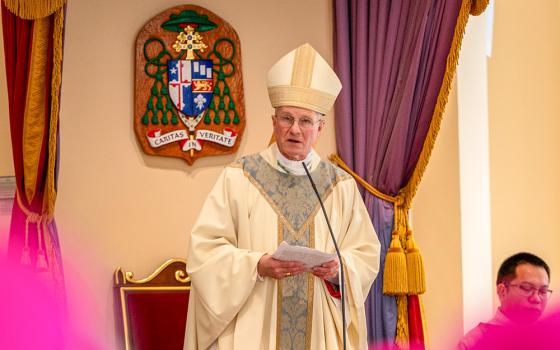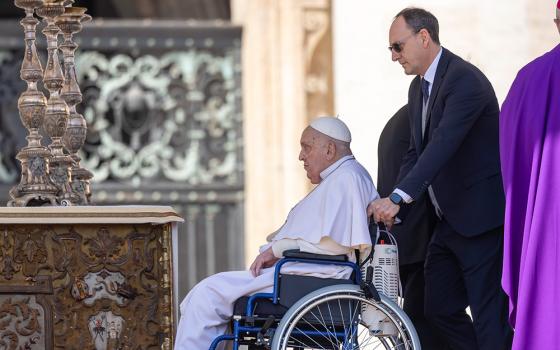
"Saint Catherine of Siena Receiving the Stigmata," an 1513-1515 painting by Domenico Beccafumi (J. Paul Getty Museum, public domain)
The premise of Colby Gordon's first book, Glorious Bodies: Trans Theology and Renaissance Literature, is contained in its opening tableau. Gordon begins his introduction, "A Trans Crux," by examining an obscure portion of Raphael Holinshed's Chronicles (1587), the two-volume British history which heavily influenced William Shakespeare, Edmund Spenser and Christopher Marlowe. It recounts two versions of the Oxford synod of 1222, now infamous for its escalation of English antisemitism.
Yet neither of Holinshed's accounts make any mention of yellow stars or segregation, but rather of the trial of several deviants accused of faking stigmata, bewitching one another or, in the case of a deacon, circumcising himself for "the loue [love] of a woman that was a Iew [Jew]." In the first version, the false stigmatic, upon his crucifixion by the archbishop of Canterbury, is discovered to be a "hermaphrodite, that is to say, both man and woman." And in the second, the unfaithful deacon is "committed to the secular power, & so burnt."
Therein lies the trans crux Gordon explores, one occupying the lethal intersection of church and state, gender and race, and corporal paranoia. In fact, the reason the synod merited any mention at all by Holinshed, over three centuries later, was its establishment of a legal precedent summarized by Frederic Maitland: "English law can burn a heretic." The heretic at hand — in reality a deacon who converted to Judaism — was cast by Holinshed as having sinned against Christendom's racial purity, and as actualizing their betrayal through a bodily modification.

With the Oxford synod, Gordon introduces his deeply interwoven themes: the political theology of transphobia, the complicity of secularism in transphobic violence and the recovery of a history of transition — all towards the politics of trans theology. Perhaps it is time, Gordon argues, to "lean into the irrational pleasures and sublime possibilities of a nonsecular transness."
Transphobia's political theology
Gordon's political theology implicates transphobia as a crucial underpinning of colonialism, white supremacy and Christian hegemony. Modern understanding of gender developed simultaneously with the Western invention of whiteness, and many contemporary accounts of gender deviance also include racial betrayal. A pattern emerges of womanhood shoring up whiteness, and of proximity to transitioned bodies as a racialized corruption of womanhood; a cosmology also emerges, where the debauched influence of the East must be kept at bay with racialized gender.
The most pervasive through line of Glorious Bodies is antisemitism, and Gordon uncovers startling congruencies between early modern antisemitism and our own versions: namely that Jewish cabals threaten the bodily integrity of Christian children; whether by ritualistically circumcising Gentile boys, or funding youth gender-surgery rackets. Gordon traces this paranoia about a "degendering cut" from the Oxford synod, through John Milton's Samson Agonistes and all the way to our current hysteria about what CatholicVote recently called "experiments on kids."
The purpose of transphobia, in Gordon's appraisal, is twofold. On one hand, gender props up race, and on the other, no moral panic generates higher returns than the wild imaginings of what "they" are doing to "our" children.
Advertisement
Secularism: Compromised and compromising
Ironically, Holinshed ascribes the motivation of reformation to the Oxford synod, positioning the events within the progressive momentum associated, according to Gordon, with the "modernizing thrust of a secularization" long associated with the Protestant Reformation. This nascent attempt at balancing ecclesiastical and governmental prerogatives, however, enforced a "violent, and retrograde form of Christian particularism." The apostate was either crucified or burned.
That cozy relationship constitutes Gordon's first objection to a secular trans paradigm: far from protecting trans people, secularism, gestating as it did alongside Reformation, Enlightenment and Empire, merely "[reinscribes] cis white Protestantism while excising religion's affirmative trans capacities." Liberalism's ostensible separation of church and state remains selective to this day, argues Gordon, who, while noting the Christian right's use of trans panic to inflame the public, reminds us that it is still the secular state who sets itself to criminalizing transness and seeking to "eliminate transition through the apparatuses of incarceration and state violence."
Just as the archbishop of Canterbury ruled heresy but let the Crown do the dirty work, so too does Pope Francis now deem transition an existential threat, while the federal courts spill the ink on the church's behalf. It is no coincidence, Gordon argues, that the same impetus lies behind the two unholy alliances: transness is secularism's kryptonite. Trans embodiments will always present a "vector of heresy and corruption" where the religious and public domains collapse together.
Gordon's second objection to a secular transness is its perpetuation of one of transphobia's chief tenets: that secularism is the "precondition of possibility for trans life," and transition a scientific novelty. This belief folds into accusations, like Francis', that transition represents a technocratic interference amounting to idolatry.
'The theological concept of glory is fundamentally about transition, our openness to the experience of being changed in ways that allow for rebirth, transformation, and self-disclosure.'
—Colby Gordon
Recovering the history of transition
Continuing its refutation of transition as a modern phenomenon, Glorious Bodies rejects clinical paradigms as inherently pathologizing and facilitating medical overreach in trans peoples' lives. Towards liberating transition from modern medicine, Glorious Bodies insists that transition is a long-standing practice.
The important thing, Gordon writes, is not whether any one figure is "really" trans, but that whether it be Anatolian Galli, Sumerian Gala or Indian Hijras, people have lived as multiple sexes and surgically modified their genitals for a very, very long time. Yet recovering these histories necessarily requires an engagement with pre-secular culture, and thus theology. Rather than responding to Christian transphobia with a secular override, Glorious Bodies attempts to locate a "trans imaginary in early modern theology."
Christianity's trans-capacities
Gordon concludes that theological ground is too important to cede, and scours early modern theology to recover queer Christian imaginings. Though much has been written about medieval traditions which assign queer imagery to holy figures, many of these idiomatic veins continued into the early modern period.
In his "Lucus 34," the Anglican cleric and poet George Herbert portrays the apostles jostling for "access to the breast," where St. John cries: "Ah now, glutton, let me suck too! ... / I claim the milk / Mingled with the blood." Here Jesus is endowed with female physiological capacities, and elsewhere Herbert "inserts Jesus at the apex position of a lactational chain," creating an image of Jesus' breast milk flowing into the mouths of infants via their mothers, to whom Jesus "dost dispose … a part." Herbert says that infants who suck their mothers also suck Christ, who becomes in Herbert's imagining the original and ultimate mother, the wellspring of all flows.
Stigmata also offers Gordon a rich source of material, particularly since the phenomenon was prevalent among women. Cardinal Ippolito d'Este sang the praises of 16th-century stigmatic Lucia Brocadelli, saying that in her "Jesus Christ Himself was transformed into a virgin." D'Este's Latin inflections are all masculine, indicating the descent of the grammatically male Jesus into the form of a girl.
St. Catherine of Siena — perhaps the most canonically indisputable stigmatic aside from St. Francis — pushed the gender variance inherent to mysticism into rapturous frontiers. Her 14th-century biographer, Dominican friar Raymond of Capua, recorded in The Life of St. Catherine of Siena his own eyewitness account of St. Catherine's miraculous transformation into "the face of a strange man" complete with a "short beard the colour of corn." Clearly, those highly favored are no more bound by sex than Jesus the birthing, breast-feeding man.
Rather than responding to Christian transphobia with a secular override, Glorious Bodies attempts to locate a "trans imaginary in early modern theology."
In the twinkling of an eye
Opening Gordon's acknowledgements is an epigraph from 1 Corinthians 15:51-52:
Listen, I tell you a mystery: We will not all sleep, but we will all be changed — in a flash, in the twinkling of an eye, at the last trumpet. For the trumpet will sound, the dead will be raised imperishable, and we will be changed.
That beautiful concluding phrase reminds me of a homily I once heard on the solemnity of Corpus Christi. The priest invited us to imagine Jesus' glorified body, and then to imagine our own. He reminded us that it was that same glorified body we were preparing to eat. I left that Mass remembering why I became Catholic.
Glorious Bodies, for me, had the same effect. In his acknowledgement, Gordon writes, "The theological concept of glory is fundamentally about transition, our openness to the experience of being changed in ways that allow for rebirth, transformation, and self-disclosure." Maybe this is why, even after his resurrection, Jesus kept his side open and available to the fingering of St. Thomas. He was reminding us to remain open, and promising us that he was always open — the way the canal is always open for new birth.
In her 2023 doctoral thesis, Maggie S. Kelly writes that Jesus is the "Ultimate Other — he is a baby born of a virgin; a man who mothers; a divine human who dies and rises again in three days' time; the second person in the Holy Trinity." With his jolting, rigorous book, Gordon reminds us not only of Jesus' otherness, but also that his otherness is inscribed on his very body, and on the bodies of his favorites.




